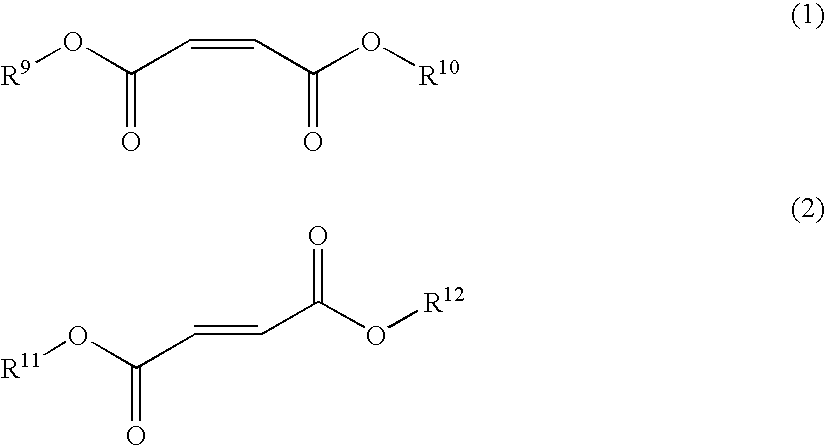Ultraviolet radiation cured powder coatings for stained wood
a technology of ultraviolet radiation and powder coating, applied in the direction of powdery paint, fibreboard, synthetic resin layered products, etc., can solve the problems of long labor intensive process, unsatisfactory finish, and high labor intensity of liquid wood coating process, and achieve uniform pore sizes
- Summary
- Abstract
- Description
- Claims
- Application Information
AI Technical Summary
Benefits of technology
Problems solved by technology
Method used
Image
Examples
examples 1-3
Effect of Solventborne Stain and Waterborne Stain on Adhesion
[0094]To determine adhesion of powder coatings to coated wood, each of three flat Red Oak panels (152.4 mm×152.4 mm×19.05 mm or 6 in×6 in. 0.75 in. thick) were pre-sanded with 220 grit sandpaper and stained with no stain (Example 1), solventborne stain (Example 2) and waterborne stain (Example 3), as set forth in Table 2, below. The applied stains were air dried for from 20 to 30 minutes at ambient temperature. The panels were then preheated for 0.5 minutes at 149° C. (300° F.) to a board surface temperature of 65° C. (160° F.). The panels were electrostatically spray coated with the extruded, impact milled coating powder (screened at 325 mesh (44 μm); average particle size of 22 μm) as set forth in Table 1, below, at a board surface temperature of 43.3° C. (110° F.) to a powder coating thickness of from 25.4 to 38.1 μm (1.0-1.5 mils). The thus applied powder layers on each panel were then flowed out for 2.5 minutes at 149...
examples 4 to 6
Effect of Waterborne vs. Solventborne Stain on Powder Coatings on Stained Wood
[0103]Four solid oak panels (152.4 mm×152.4 mm×19.05 mm or 6 in.×6 in. 0.75 in. thick) were pre-sanded with 220 grit sandpaper. The stain was applied to each panel as indicated in Table 3, below, and each panel was then air dried for 10 minutes, followed by curing for 20 minutes at 49° C. (120° F.). The resulting stained panel having a board surface temperature of 110° F. (43.33° C.) was then powder coated electrostatically with the powder coating composition shown in Table 1 post heated at 300° F. (149° C.) for 3 minutes and UV cured using 600 watt mercury lamps with a 1200 mj / cm2 dosage.
[0104]
TABLE 3BINDERADHESIONEXAMPLECOMPOSITIONPIGMENTSRATING4Solventborne WipingBurnt umber,1Stain:transparent redSoya and linseed oiloxide, van dykeoxidizing alkydsbrown, dinitro-aniline orange, rawumber, carbon blackand TiO2.5Solventborne WipingBurnt umber,1Stain:transparent redSoya and linseed oiloxide, van dykeoxidizin...
PUM
| Property | Measurement | Unit |
|---|---|---|
| particle size | aaaaa | aaaaa |
| total thickness | aaaaa | aaaaa |
| thick | aaaaa | aaaaa |
Abstract
Description
Claims
Application Information
 Login to View More
Login to View More - R&D
- Intellectual Property
- Life Sciences
- Materials
- Tech Scout
- Unparalleled Data Quality
- Higher Quality Content
- 60% Fewer Hallucinations
Browse by: Latest US Patents, China's latest patents, Technical Efficacy Thesaurus, Application Domain, Technology Topic, Popular Technical Reports.
© 2025 PatSnap. All rights reserved.Legal|Privacy policy|Modern Slavery Act Transparency Statement|Sitemap|About US| Contact US: help@patsnap.com



